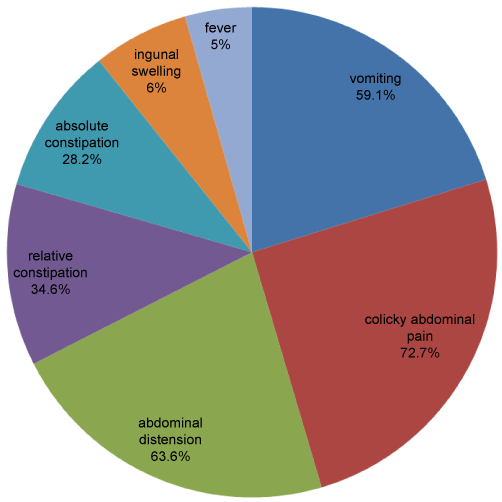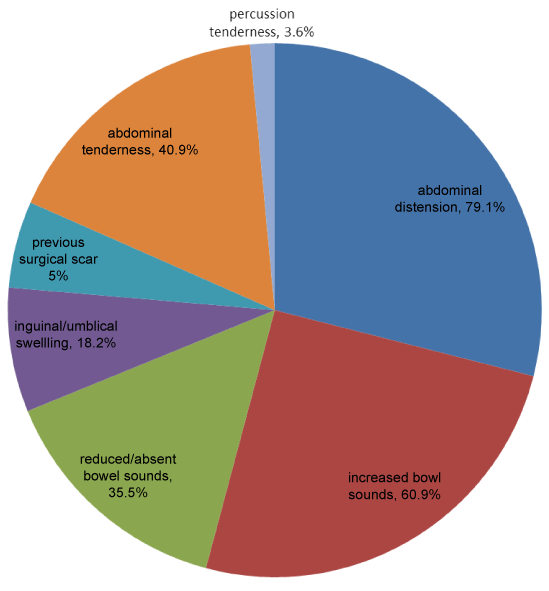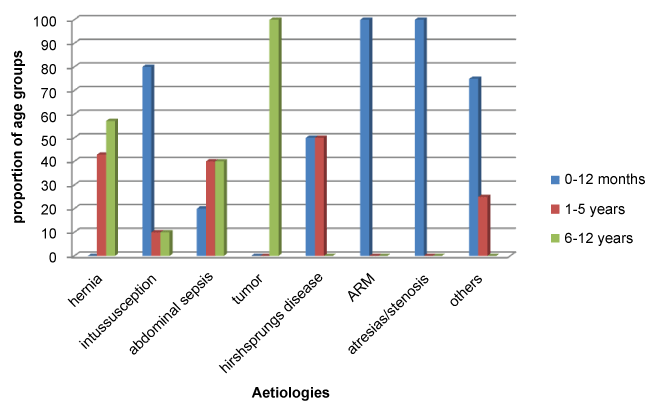International Journal of Critical Care and Emergency Medicine
Aetiology and Presentation of Intestinal Obstruction among Patients Presenting to a Tertiary Hospital in Uganda
Arlene Muzira Nakanwagi1, Stephen C Kijjambu1, Peter Ongom (RIP)1 and Tonny Stone Luggya2*
1Department of Surgery, Makerere University, Uganda
2Department of Anesthesia, Makerere University, Uganda
*Corresponding author:
Tonny Stone Luggya, Department of Anesthesia, Makerere University, Uganda, Tel: +256772380880, E-mail: tluggya@yahoo.com
Int J Crit Care Emerg Med, IJCCEM-2-018, (Volume 2, Issue 2), Research Article; ISSN: 2474-3674
Received: January 20, 2016 | Accepted: June 01, 2016 | Published: July 04, 2016
Citation: Nakanwagi AM, Kijjambu SC, Peter Ongom (RIP), Luggya TS (2016) Aetiology and Presentation of Intestinal Obstruction among Patients Presenting to a Tertiary Hospital in Uganda. Int J Crit Care Emerg Med 2:018. 10.23937/2474-3674/1510018
Copyright: © 2016 Nakanwagi AM, et al. This is an open-access article distributed under the terms of the Creative Commons Attribution License, which permits unrestricted use, distribution, and reproduction in any medium, provided the original author and source are credited.
Abstract
Background:Intestinal Obstruction is the impairment of normal flow of intestinal contents from mouth to anal canal with aetiology that varies depending on various factors. Understanding aetiology of a country's surgical services has proven to aid better planning for its emergency surgical conditions. Mulago, which is Uganda's National Referral Hospital, is resource constrained with a surgical burden of 33% due to acute abdomen with Intestinal Obstruction. This study aimed to determine the current presentation pattern and etiological factors of Intestinal Obstruction at Mulago.
Materials and methods:Ethical approval was got, from Makerere University School of Medicine IRB, to carry out a prospective observational study among surgical patients admitted to Mulago Hospital's surgical wards and units. All patients admitted to the hospital for the study period that fitted the inclusion criteria, with suspected partial or complete Intestinal Obstruction or those with confirmed diagnosis intraoperatively were consented and enrolled.
Results:We recruited 110 with 79 (71.8%) males and 31 (28.2%) females. Paediatric patients of 0-12 years were 45 (41.0%) and 65 (59%) were adults above 13 years. We had 50% that presented after 72 hrs of symptoms, 24.6% of these were initially managed in a health centre and only 7.3% of the participants presented within 24 hours. The commonest symptoms that presented were colicky abdominal pain, vomiting, abdominal distension and relative constipation. Hernias were the commonest cause of Intestinal Obstruction in adults followed by gut volvulus then adhesions and tumours while in the paediatric group had intussusceptions as the most common aetiological factor followed by Anorectal malformations and then congenital atresia plus stenosis as third commonest cause of in children respectively.
Conclusion:Hernias followed by intestinal volvulus were the commonest adult aetiology while intussusceptions followed by Anal Rectal Malformations were the commonest paediatric aetiology of intestinal obstruction. In Mulago hospital with colicky abdominal pain, abdominal distension and vomiting as the commonest presenting symptoms with males the predominantly affected sex.
Keywords
Acute abdomen, Gastrointestinal surgery, Intestinal obstruction
Abbreviations
IO: Intestinal Obstruction, ARMs: Anal Rectal Malformations, MNRTH: Mulago National Referral and Teaching hospital
Introduction
Intestinal obstruction (IO) is defined as an impairment, arrest or reversal of the normal flow of intestinal contents from mouth to anal canal and the obstruction can be located in the small bowel (SBO) where is termed as high bowel obstruction or it could be in the large bowel where it's called low bowel obstruction (LBO) [1]. The aetiological factors of IO vary due to geographical location with dependence on staple diets, lifestyle, genetic factors and health seeking behaviour of a people plus the access to surgical services and degree of health sophistication of a region or country [2-5]. In advanced surgical healthcare systems like in the USA the leading cause of obstruction is adhesions (74%) followed by Crohn's disease and neoplasm and hernias [6] and this is similarly reflected in Greece where adhesions (64.8%), hernias (14.8%) and large bowel tumours were common aetiologies with 76% of the patients having SBO while 24% had LBO [7]. In low resource settings the trend consists of hernias, malignancies, adhesions and the unique presence of tuberculosis strictures at a frequency of 14.7% in India [8], while in West Africa the leading aetiological factor noted was obstructed inguinal hernia (45.7%) with an increased proportion of obstruction due to tumours [9]. Some aetiology is unique to Africa e.g. in Mulago five decades ago Ascaris Lumbricoides was found as a common cause of obstruction [10]. However much as aetiology varies from country to country regionally there are similar trends for example studies in Ghana have shown hernias (59%) followed by adhesions and intussusceptions as the commonest cause of obstruction [11] while in Nigeria it was similarly reflected with hernias (35%), adhesions (26%) and malignancy (9.4%) causing obstruction [12,13], generally in Africa IO is still the leading cause of acute abdomen [3]. Mulago which is Uganda's National referral and Makerere University teaching hospital has staff inadequacies like lack of motivation and lack professionalism due to poor pay and this is coupled with overcrowding, a poorly functioning referral system, limited quality assurance and a cumbersome procurement system [14]. Due to paucity of data in our setting yet raw data shows a surgical burden of 33% due to acute abdomen with an average of 15-20 cases of IO operated on a month and that sometimes shooting up to 20-30 in some months. Also since understanding aetiology gives a good indication of how well a country's surgical services are doing [15], we thus aimed to study the current aetiological factors and clinical presentation patterns of IO at Mulago National Referral and Teaching Hospital (MNRTH).
Materials and Methods
We obtained ethical approval from Makerere University School of Medicine Research and ethics committee to conduct a prospective descriptive study from 1st December 2013 to 31st May 2014 on all the surgical units of MNRTH, with a bed capacity of 1500 [16] and whose Accident and Emergency (A&E) department receives averagely 48,000 patients per year.
Our inclusion criteria was; Male/female patients of all ages, Patients with suspected partial or complete IO based on symptoms and signs, or those that have at least one radiological investigation suggestive of IO, Referred patients with a confirmed diagnosis of partial or complete IO presenting to Mulago Surgical Units either through A&E, Ward 3B-Emergency Surgery or Surgical Out Patient Department and that gave informed consent were enrolled. Consent from the very sick was obtained later after stabilization. Patient's initials and study numbers were used as identifiers. Data management and analysis: we used interviewer administered, semi structured and pretested questionnaires for data collection, it was cleaned, coded and analysed it in STATA 10.1. Results were reported using proportions, means, medians and inter-quartile ranges. Univariate and bi-variate analysis was done and measurements of associations were also carried out using Pearson Chi-X2 values and P values. Aetiology as per the age group was also configured in bar graphs while proportions and frequencies of occurrence for various aetiologies among study participants were obtained from history, physical examination, investigations and documented findings at laparotomy.
Results
We recruited 110 patients with symptoms, signs and with at least one radiological investigation suggestive of Intestinal Obstruction. For demographic characteristics we had 79 (71.8%) males and 31 (28.2%) females a ratio of 2.6:1. Paediatric patients of 0-12 years were 45 (41.0%) and 65 (59%) were adults above 13 years with 20% of the adults were above 50years of age. The participants that were married were 30% and 18% were single, with 67.3% having some level of education of which 14.6% had progressed to a tertiary education level as shown in table1.
![]()
Table 1: Demographic characteristics of the study participants.
View Table 1
Clinically at presentation 50% of the participants presented after 72 hrs of symptoms, 24.6% of these were initially managed in a healthcare centre before reaching MNRTH with only 7.3% of the participants presenting within 24 hours of symptomatology. Symptom duration had a weak statistical association with choice of management, p = 0.055. Colicky abdominal pain (72.7%), abdominal distension (63.6%) and vomiting (59.1%) were the 3 commonest symptoms (Table 2 and Figure 1). While abdominal distension (79.1%), increased bowel (boborygmi) sounds (60.9%) plus abdominal tenderness (40.9%) were the commonest signs on examination (Figure 2 and Table 3). Hernias (20.9%) cut across board as the commonest cause of IO and in adults this was followed by gut volvulus (11.8%) then adhesions and tumours (8.2%) then Atresia and stenosis (5.5%) of bowel segments was 3rd as shown in table 3.
![]()
Table 2: Presenting symptoms by grouped aetiologies of IO.
View Table 2
In the paediatric age group; Intussusceptions (9.1%) was the most common aetiological factor followed ARM (8.2%) and then congenital Artesia's and stenosis (5.5 %) mainly affecting the neonates (0-12 month) as illustrated in figure 3. Majority of the obstruction was small bowel obstruction at 64% with hernias contributing the most to this percentage across both age groups as shown in table 3.
![]()
Table 3: Aetiology, signs and level of obstruction.
View Table 3
Discussion
This study aimed to determine the current aetiological factors and presentation patterns of IO in the surgical units at MNRTH and the study showed high incidence of obstructed inguinal hernias due to strangulated bowel which was mostly small bowel in adults while in the paediatric age group intussusceptions (9.9%) were the commonest aetiology for intestinal obstruction and this was followed by ARMs (8.2%). IO is a significant burden locally and also internationally as it accounts for a great proportion of emergency room visits [17,18]. Also regional studies have shown that understanding aetiology gives a good indication of how well a country's surgical services are doing and thus improving community surgical practice from this knowledge reduces intestinal obstruction associated mortality [15]. This study showed hernias as the commonest aetiology across board contrasting sharply with older study findings showing intestinal infestations as the commonest cause of Intestinal Obstruction [10]. The finding of hernias predominating was geographically similar but lower frequency than in northern where hernias accounted for 40.2% [19] pointing to hernias as a significant surgical issue in Uganda. This finding is also a reflection of the African continent where hernias are leading cause of obstruction [15,20,21] which may be due to lack of surgical services [22]. Demographically in this study we had 59% adults and 41.0% paediatric population with more males (71.8%) than females (28.2%) affected, a pattern similar to other Ugandan studies [19,23]. The predominance of the male gender may be attributable to the fact that in the among the adult and paediatric age groups the commonest causative factors was obstructed hernias and ARMs respectively and these occur more commonly in the males [1]. The level of education had a significant association with the aetiology of IO because education is perceived to drive individuals towards better health seeking habits thus leading to earlier/elective repair of hernias. Gut volvulus (12.7%) was the second commonest cause of IO with all cases occurring in adults and these findings were similar other studies done at different sites in the capital city Kampala [24]. Intussusceptions in the paediatric age group were commonest aetiology for intestinal obstruction, a finding concurrent with other African countries i.e. Nigeria and Tanzania in which they did their analysis of intussusceptions in the under 10 children [25,26]. We didn't have any case of adult intussusceptions presenting in this study as its rare cause of obstruction as noted in earlier studies done in Uganda [27].
Study limitations
We had an issue of recall bias as some information was extracted from patient records and doctor interviews and quality of medical records may have affected the quality of some of the study variables this was coupled with inability to get patients diet history.
Conclusion
• Obstructed hernias were the leading cause of intestinal obstruction across board in Mulago hospital mainly affecting the adults and followed by intestinal volvulus then adhesions respectively.
• Intussusceptions was the commonest paediatric aetiology followed respectively by Anal Rectal Malformations and Artesia's & stenosis.
• Colicky abdominal pain, abdominal distension, vomiting and relative constipation were the commonest presenting symptoms with Males the most affected gender.
Competing Interests
This was academic research and the authors declare that they have no competing interests.
Co-author Contribution
Associate Professor SK and PO (RIP) guided me through my research proposal development from concept through to completion. Dr TSL helped with building the research concepts, final proposal and manuscript completion.
Acknowledgement
A vote of thanks goes to the lecturers, Members, colleagues, in the department of Surgery, Makerere University. Also to Mulago hospital Accident and emergency dedicated staff plus surgical wards for continued work and perseverance despite the challenges.
References
-
Townsend CM (2004) Sabiston textbook of surgery 17th Edition Pennsylvania WB: Elsevier-Saunders.
-
Cole GJ (1965) A Review of 436 Cases of Intestinal Obstruction in Ibadan. Gut 6: 151-162.
-
Ajao OG (1981) Abdominal emergencies in a tropical African population. Br J Surg 68: 345-347.
-
Archampong E, Naaeder S, Darko R (2000) Changing pattern of intestinal obstruction in Accra, Ghana. Hepato-gastroenterology 47: 185.
-
de Silva NR, Guyatt HL, Bundy DA (1997) Morbidity and mortality due to Ascaris-induced intestinal obstruction. Trans R Soc Trop Med Hyg 91: 31-36.
-
Miller G, Boman J, Shrier I, Gordon PH (2000) Etiology of small bowel obstruction. Am J Surg 180: 33-36.
-
Markogiannakis H, Messaris E, Dardamanis D, Pararas N, Tzertzemelis D, et al. (2007) Acute mechanical bowel obstruction: clinical presentation, etiology, management and outcome. World J Gastroenterol 13: 432.
-
Souvik A, Hossein MZ, Amitabha D, Nilanjan M, Udipta R (2010) Etiology and outcome of acute intestinal obstruction: A review of 367 patients in Eastern India. Saudi journal of gastroenterology: official journal of the Saudi Gastroenterology Association 16: 285.
-
Shittu OB, Gana JY, Alawale EO, Ogundiran TO (2001) Pattern of mechanical intestinal obstruction in Ibadan: a ten year review. Afr J Med Med Sci 30: 17-21.
-
McAdam I (1961) A three year review of intestinal obstruction: Mulago Hospital, Kampala, Uganda. Eest Afr J Med 38: 536-543.
-
Archampong EQ, Naaeder SB, Darko R (2000) Changing pattern of intestinal obstruction in Accra, Ghana. Hepatogastroenterology 47: 185-193.
-
Madziga AG, Nuhu AI (2008) Causes and treatment outcome of mechanical bowel obstruction in north eastern Nigeria. West Afr J Med 27: 101-105.
-
Lawal OO, Olayinka OS, Bankole JO (2005) Spectrum of causes of intestinal obstruction in adult Nigerian patients. S Afr J Surg 43: 34, 36.
-
Kizza IB, Tugumisirize J, Tweheyo R, Mbabali S, Kasangaki A, et al. (2011) Makerere University College of Health Sciences' role in addressing challenges in health service provision at Mulago National Referral Hospital. BMC Int Health Hum Rights 11: S7
-
Ntakiyiruta G, Mukarugwiro B (2009) The Pattern of intestinal Obstruction at Kibogola Hospital, a Rural Hospital in Rwanda. East Cent Afr J Surg 14: 103-108.
-
http://directory.africa-business.com/product_desc.php?id=9103.
-
Miller G, Boman J, Shrier I, Gordon PH (2000) Natural history of patients with adhesive small bowel obstruction. Br J Surg 87: 1240-1247.
-
Mucha P Jr (1987) Small intestinal obstruction. Surg Clin North Am 67: 597-620.
-
Okeny P, Hwang T, Ogwang D (2011) Acute Bowel Obstruction in a Rural Hospital in Northern in Northern Uganda. East Cent Afr J Surg 16.
-
Ohene-Yeboah M, Adippah E, Gyasi-Sarpong K (2006) Acute intestinal obstruction in adults in kumasi, ghana. Ghana Med J 40: 50-54.
-
Otu AA (1991) Tropical surgical abdominal emergencies: acute intestinal obstruction. Afr J Med Med Sci 20: 83-88.
-
Holcombe C (1995) Surgical emergencies in tropical gastroenterology. Gut 36: 9-11.
-
Kintu-Luwaga R, Galukande M, Owori FN (2013) Serum lactate and phosphate as biomarkers of intestinal ischemia in a Ugandan tertiary hospital: a cross-sectional study. Int J Emerg Med 6: 1-7.
-
Kakande I, Ekwaro I, Obote W, Nassali G, Kyamanywa P (2003) The intestinal Volvulus at St. Francis Hospital, Kampala. East and Central Afr J Surg 6: 21-24.
-
Ogundoyin O, Afolabi A, Ogunlana D, Lawal T, Yifieyeh A (2009) Pattern and outcome of childhood intestinal obstruction at a Tertiary Hospital in Nigeria. African health sciences 9.
-
Carneiro PM, Kisusi DM (2004) Intussusception in children seen at Muhimbili National Hospital, Dar es Salaam. East Afr Med J 81: 439-442.
-
Ongom PA, Opio CK, Kijjambu SC (2014) Presentation, aetiology and treatment of adult intussusception in a tertiary Sub-Saharan hospital: a 10-year retrospective study. BMC Gastroenterol 14: 86.








